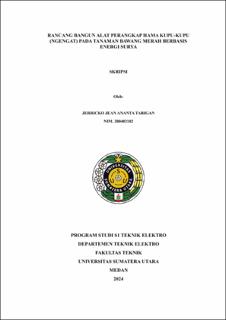Rancang Bangun Alat Perangkap Hama Kupu-Kupu (Ngengat) pada Tanaman Bawang Merah Berbasis Energi Surya
Design and Construction of a Solar Energy-Based Butterfly (Moth) Pest Trap for Red Onion Plants

Date
2024Author
Tarigan, Jerricko Jean Ananta
Advisor(s)
Mubarakah, Naemah
Bukit, Ferry Rahmat Astianta
Metadata
Show full item recordAbstract
Shallot is a high-value commodity essential for national consumption, farmer income, and export potential. However, moth pest infestations pose a significant challenge. Farmers commonly rely on pesticides, despite their excessive use potentially causing environmental pollution. In Saran Padang Village, farmers utilize LED lamps and water-filled buckets as moth traps at night. However, limited electricity supply often shortens the operational duration of the lamps. To address this issue, Solar Power Plants (PLTS) offer a sustainable solution to overcome electricity constraints in farming areas and support environmentally friendly pest control methods. This study aims to design and test the effectiveness of solar-powered moth traps for shallot cultivation. The system employs a 50 WP polycrystalline solar panel as the energy source to power blue ultraviolet lamps with three power variations: 9 watts, 11 watts, and 13 watts. The lamps operate for 10 hours nightly, with a testing period of five days for each power setting. The results indicate that lamp power variations significantly influence the number of pests trapped and the effective trap radius. The 13-watt lamp captured the highest number of pests, including 187 Spodoptera exigua and 132 Spodoptera litura, with an effective radius of up to 6 meters. This study demonstrates that increasing ultraviolet lamp power enhances pest capture rates and expands the effective trap range, with the optimal power being 13 watts.
Collections
- Undergraduate Theses [1534]
